Servicios Personalizados
Revista
Articulo
Indicadores
-
 Citado por SciELO
Citado por SciELO
Links relacionados
-
 Similares en
SciELO
Similares en
SciELO
Compartir
Acta Odontológica Latinoamericana
versión On-line ISSN 1852-4834
Acta odontol. latinoam. vol.27 no.1 Buenos Aires mayo 2014
ARTÍCULOS ORIGINALES
Effect of a new remineralizing biomaterial on the color of dental enamel
Paula K. Vargas-Sánchez1, Édgar Delgado-Mejía2, Carolina Torres-Rodríguez1
1 Department of Oral Health, Faculty of Dentistry, National University of Colombia
2 Department of Chemistry, Faculty of Sciences, National University of Colombia
CORRESPONDENCE Dr. Carolina Torres Rodriguez. Ciudad Universitaria, Cra 30 Cll 45-03 Edificio 210, oficina 308, Bogota- Colombia ctorresr@unal.edu.co
ABSTRACT
The aim of this research was to describe the effects of altering the composition of a modified remineralizing agent (MRA) and the osmotic pressure on tooth color by using spectrophotometric analysis. One hundred and four (104) human premolars and molars were randomly divided into 2 groups of 52 specimens each. Group 1 was treated with the remineralizing agent MRA 55, (remineralizing agent 1), a 50% - 50% by weight mixture of coarse-grain and fine-grain generating minerals, and group 2 was treated with the remineralizing agent MRA 91 (remineralizing agent 2), containing the same minerals in a 90% - 10% proportion. Each group was divided into 2 subgroups with 26 specimens each, which were stored as follows: subgroups A were stored in synthetic saliva with isotonic osmotic pressure (IP), and subgroups B in hypotonic osmotic pressure saliva (HP). The initial and final readings were taken with a Vita Easy ShadeR spectrophotometer. Color parameters (L*, a*, b*) and whiteness indices (WIC, WIO, W) were calculated from the readings. The color changes (?L, ?A, ?B, and ?E) and whiteness indices were compared and analyzed with descriptive analyses. The variables ?L, ?A, ?B, ?E, and the whiteness index W were analyzed with an analysis of variance (ANOVA), and the indices WIC and WIO were analyzed with a nonparametric Kruskal-Wallis ANOVA. The results indicate that combination A2 (MRA 91 and IP) affected variables ?B and ?E, while combination B1 (MRA 55 and HP) affected variables ?A, ?B and the whiteness index WIO. Only MRA 91 affected the variable ?L. The osmotic pressure of saliva and the remineralizing agent used affect the color of dental enamel.
Keywords: Dental enamel; Tooth Bleaching Agents; Spectrophotometry; Tooth remineralization.
RESUMEN
Efecto de un nuevo biomaterial remineralizante sobre el color del esmalte dental
El objetivo de este trabajo fue describir el efecto de la composicion de una sustancia remineralizante (SRM) y de la presion osmotica sobre el color dental mediante espectrofotometria. Se tomaron 104 premolares y molares humanos repartidos aleatoriamente en 2 grupos, cada uno de 52 especimenes. El grupo 1 se trato con la sustancia remineralizante SRM 55 (agente remineralizante 1) mezcla de 50% - 50% de mineral de grano fino y otro mineral de grano grueso y el grupo 2 se trato con la sustancia remineralizante SRM 91 (agente remineralizante 2) contienen los mismos minerales en proporcion 90% - 10%. A su vez cada grupo se dividio en 2 subgrupos, cada uno de 26 especimenes que se almacenaron asi: Un subgrupo en saliva sintetica con presion osmotica isotonica (PI) y el otro con presion osmotica hipotonica (PH). Se tomaron registros iniciales y finales con el espectrofotometro Vita Easy ShadeR. Con las lecturas se calcularon los parametros de color (L*; a*; b*) y los indices de blanqueamiento (WIC; WIO; W). Los cambios de color (?L; ?A; ?B; y ?E) y los indices de blanqueamiento se compararon y se trataron todos mediante un analisis descriptivo. Las variables ?A, ?L, ?B, ?E e indice de blanqueamiento W se trataron con ANOVA y los indices WIC y WIO con un analisis de varianza no parametrico Kruskal Wallis. Los resultados indican que la combinacion A2 (SRM 91 y PI) afecto las variables ?B y ?E. La combinacion B1 (SRM 55 Y PH) afecto las variables ?A, ?B y el indice de blanqueamiento WIO. Solamente SRM 91 afecto la variable ?L. La presion osmotica de la saliva y la sustancia remineralizante afectan el color del esmalte dental.
Palabras clave: Esmalte dental; Agentes blanqueadores; Espectrofotometria; Remineralizacion dental.
INTRODUCTION
Color is the result of the incidence of light rays that interact with a body or the physiological response to physical stimuli1. Color has also been defined as a psychophysical response to the physical interaction of light energy with an object and is thus the subjective experience of an observer. Color is a complex phenomenon in which several factors converge, such as lighting, translucency, opacity, light scattering, brightness, the eye, and the human brain, which influence the overall perception of color. The light source, the observer, and the observed object can all influence color perception2.
There are various phenomena associated with the interaction between teeth and the luminous flux, which include the following: light transmission through the tooth, the specular reflection from the tooth surface, the diffusion of light on the surface, multiple refraction, and light absorption and scattering within dental tissues. Concerning color, the 1976 International Commission on Illumination (Commission Internationale De L´Eclarage, CIE) introduced the 3-dimensional representation of a perceived color stimulus (L*, a*, b*). L* represents brightness as the difference between light (L*=100) and dark (L*=0), a* represents the value on the red-green axis, and b* represents the value on the blue-yellow axis3.
The L*a*b* color space provides a 3-dimensional representation of color perception, and the corresponding deltas (?L, ?A, and ?B) are a measure of the color difference, which is the Euclidean distance4 between the 2 points in 3-dimensional space, indicated as ?E.
Some authors have described different color measurement methods, such as the use of spectrophotometers, colorimeters, digital cameras, imaging systems, and the Munsell system. The spectrophotometer is an instrument for color measurement that measures the spectral reflectance components of a color and converts them to an internationally recognized numerical value. Spectrophotometric measurement also includes spectral data and provides a detailed definition of the color4.
The spectrophotometer is a highly accurate, useful, and flexible instrument that measures color in general3,5. In dentistry, a spectrophotometer allows for the determination of color in natural teeth and restorations, as well as a wide range of other color measurements including the analysis of whitened teeth4. In recent years, tooth whitening has become a popular new trend that many scientists and dentists have investigated. Some authors report that the color change in whitened teeth mainly occurs due to changes in the subsurface dentin color, while others argue that it is caused by a change in the translucency of the enamel. Finally, it has been shown that both enamel and dentin are altered by whitening agents, with enamel being the most affected6.
Whitening agents cause changes in enamel, such as the formation of pores and microfractures, erosion, crystallite disruption, decrease in hardness and microhardness, increase in roughness and susceptibility to discoloration, demineralization through protein denaturation, and loss of mineral content7.
There are 3 indices, W, WIC, and WIO, which use the L*, a*, and b* values to measure tooth whitening and are defined as follows: The whiteness index W is the distance between a given value and the value of a nominal white point3 and is defined as:
W = 100 - v (100 – L*)2+ a*2 + b*2.
The whiteness index WIC is generally used in the textile, paint, and plastics industries3 and is defined as:
WIC = Y + 800 (Xn-X) + 1700 (Yn-Y).
The whiteness index WIO is based on the values of the Vita 3D-shade guide3 and is more specific for measuring whitened teeth8. The WIO is defined as:
WIO = Y + 1075.012 (Xn-X) + 145.516 (Yn-Y).
The modified remineralizing agent (MRA) is a biomimetic product composed of 2 agents: a modified conditioner (MC) based on eggshell extract and a remineralizing agent (RA) based on calcium and phosphates9. Artificial saliva is prepared under established parameters and proves useful in research because collecting natural saliva under the same conditions is difficult. Artificial saliva differs from natural saliva in that it lacks the protein content of natural saliva. The aim of this study was to examine the effects of the constitution of an MRA and osmotic pressure on tooth color with spectrophotometry. The hypothesis is that the osmotic pressure of the conservation medium for the specimens and the MRA composition affect the color of tooth enamel.
MATERIALS AND METHODS
One hundred and four (104) human premolars and molars were collected after extraction for orthodontic reasons. The study was approved by the Ethics Committee of the School of Dentistry at the National University of Colombia, and each patient was informed in writing of the procedure to be performed on the specimens and signed an informed consent. The study complied with the regulations provided in Resolution No. 008430 of October 4, 1993 from the Ministry of Health of the Republic of Colombia, which sets the scientific, technical, and administrative standards for health research.
The collected samples were extracted from individuals of either sex between 15 and 40 years of age. Teeth were selected according to the following criteria: the absence of developmental abnormalities, such as hypoplasia or amelogenesis imperfecta, a non-history of fractures or treatments with adhesive systems, whitening, rehabilitation, or endodontic procedures, and the absence of any carious lesions in the teeth. After the cleaning and disinfection phase, the remaining periodontal ligament was detached, and the tooth was immersed in a solution of 0.5% chloramine-T. The teeth were then washed and dried with paper towels, and 2% formaldehyde was applied to the apical foramen with an endodontic file with the tip coated with cotton. The apex was sealed with self-curing acrylic, and the root was covered with red nail enamel and allowed to air dry. The samples were then stored again in 0.5% chloramine-T at 4° C.
Four marks, at the corners of an imaginary square, were carved in the middle third of the vestibular surface of each tooth with a round . carbide bur with a high-speed NSKR handpiece to define the work area.
The initial color of the 104 wet specimens was measured with a previously calibrated Vita Easy ShadeR Spectrophotometer. All of the specimens underwent a very smooth surface sanding with 1000 grit tungsten carbide sandpaper, after which they were washed with a toothbrush, water, and sodium lauryl sulfate for 5 seconds. The specimens were then divided into 4 subgroups of 26 specimens each for treatment with the MRA prepared with 2 compositions. The first (MRA 55) consisted of 50% RA and 50% MC, and the second (MRA 91) was composed of 90% RA and 10% MC. The MRA 55 or MRA 91 agents were applied manually within the 4 marks of the designated area, and allowed to act for 6 hours. The teeth were then washed again with a brush and water to remove the non-adhesive material. Four subgroups were defined as follows: subgroup 1 had hypotonic saliva and MRA 55, subgroup 2 had hypotonic saliva and MRA 91, subgroup 3 had isotonic saliva and MRA 55, and subgroup 4 had isotonic saliva and MRA 91 (Table 1).
Table 1: Subgroup classification.

The specimens were polished with fine-grain pink colored ShofuR disks with a low speed NSKR handpiece, and a second color measurement was performed on these surfaces with the Easy Vita ShadeR Spectrophotometer. The values obtained for ?A, ?L, ?B and ?E were recorded in a data table. The whiteness indices W, WIC, and WIO were calculated according to the formulas reported in the article published by Wen Luo3. A statistical analysis was later performed using the Shapiro test, which evaluated the hypothesis of normality of the data to establish which variance analysis should be performed. All of the values were analyzed using multiple comparison t-tests, which determined the most effective combination using a graph of interactions.
RESULTS
The variables analyzed in this study were ?A, ?L, ?B, ?E, and the whiteness indices W, WIC, and WIO, and for statistical purposes, the results were handled according to Table 1.
A descriptive analysis was performed for all of the data. A parametric analysis of variance (ANOVA) was performed for ?A, ?L, ?B, ?E, and whiteness index W readings. A nonparametric Kruskal-Wallis ANOVA was performed for the whiteness indices WIO and WIC because the data did not meet the assumptions of normality and constant variance. In the descriptive analysis, subgroup B1 had the largest change in variables ?A (Fig. 1) and ?B. Subgroup A2 had a greater change in variables ?L and ?E (Fig. 2).
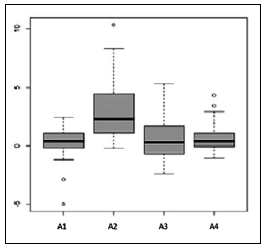
Fig. 1: Box plot of the descriptive analysis of the variable Delta A.
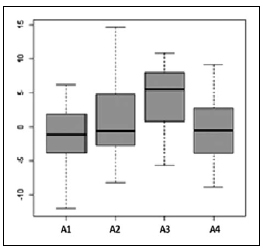
Fig. 2: Box plot of the descriptive analysis of the variable Delta E.
DELTA A
The ANOVA analysis (Table 2) indicated the significant effects of the type of agent, the osmotic pressure, and the type of agent-osmotic pressure interaction on enamel color (?A). The ANOVA treatment of the data was followed by a multiple comparisons analysis, and it was determined that all combinations had a similar effect, except combination B1 corresponding to HP and MRA 55, which was significantly higher.
Table 2: ANOVA for ?A.
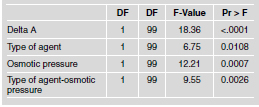
DELTA L
The ANOVA indicated that the interaction between the type of agent and the osmotic pressure was not significant. By adjusting the model, it was observed that MRA 91 had a significant effect on brightness (see Table 3).
Table 3: ANOVA for the variable ?L.

DELTA B
The ANOVA (Table 4) indicated that MRA 55, MRA 91, IP, and HP separately had no significant effect on ?B (the blue-yellow balance). An analysis of multiple comparisons was performed, and the results indicate that the most effective combinations were B1 (HP and MRA 55) and A2 (IP and MRA 91), and the combination with the least effect was A1 (IP and MRA 55).
Table 4: ANOVA for the variable ?B.
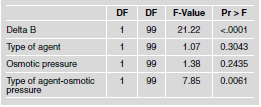
DELTA E
An ANOVA of the variable ?E indicated that the interaction between the type of agent and the osmotic pressure had a significant effect on dental enamel color (Table 5). An analysis of the combinations revealed that the combination that had the greatest effect was A2 (IP and MRA 91), and the combination that had the least effect was A1 (IP and MRA 55).
Table 5: ANOVA for the variable ?E.
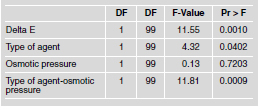
WHITENESS INDEX W
The ANOVA indicated that the interaction between osmotic pressure and type of agent had a significant effect on the whiteness index W (Table 6). An analysis of the combinations was then performed, and the combination that had the greatest effect on the whiteness index W was A1 (IP and MRA 55). The combination with the least effect on the whiteness index W was B1 (HP and MRA 55).
Table 6: ANOVA for the index W.
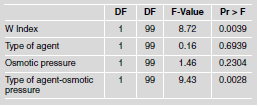
WHITENESS INDEX WIC
The Kruskal-Wallis test (Table 7) was performed to observe the within-group and inter-group interaction, and the null hypothesis of equal treatment was rejected. An analysis was performed on the interaction between type of agent and osmotic pressure (see Table 8) and indicated that neither the osmotic pressure nor the type of agent has an effect on the whiteness index WIC.
Table 7: Kruskal-Wallis for the index WIC.

Table 8: Analysis of the effect of the type of agent on the whiteness index WIC.

WHITENESS INDEX WIO
The Kruskal-Wallis test (Table 9) was performed for the whiteness index WIO, and the hypothesis of equal treatment was rejected because the P value was equal to 0.0042. The combinations of treatments were analyzed to determine which had the greatest effect on the whiteness index WIO, and B1 (HP and MRA 55) was found to be the most effective treatment.
Table 9: Kruskal-Wallis analysis for the whiteness index WIO.

DISCUSSION
The results indicate that type of agent and osmotic pressure affected tooth color in ?A, ?B, ?E, and the index W. For ?A, the combination B1 (HP and MRA 55) generated more change in the red-green balance, tending more toward red. For ?B, the combination B1 (HP and MRA 55) and the combination A2 (IP and MRA 91) generated more change in the blue-yellow balance, tending more toward yellow. MRA 91 was the composition that increased brightness (?L) the most. ?E, which represents the Euclidean distance between the initial and final L*, a*, and b* values, revealed that the combination A2 (IP and MRA 91) had greater variation; however, this does not indicate the quality of the change, but the magnitude. For the whiteness index W, the combination A1 (IP and MRA 55) resulted in the most change. The whiteness index WIC revealed no significant result. The combination with greatest effect on the whiteness index WIO was B1 (HP and MRA 55).
Because the chemical composition of the MRA is similar to enamel, it contains no oxidants or products that could destroy organic materials, nor does it have any detrimental effects on the enamel. This lack of reactivity contrasts with conventional bleaching agentsall of which are based on peroxides, which cause protein denaturation and the loss of mineral content7. This agent forms deposits of calcium and phosphorus minerals and produces a color change on the tooth surface, in brightness, and in the blue-yellow and red-green balances. This was verified by obtaining changes in the tristimulus values L*, a*, b* and measuring the whiteness indices.
The more intensely white appearance of MRA 55 may be explained because it has a smaller particle size, which promotes refraction and therefore enhances the perception of whiteness. Another side effect of the reduction of particle size is that the finest mineral particles are packed more densely, which increases the number of refractive particles per unit volume, thereby enhancing the appearance of whiteness.
Comparing the results of the CIE Lab tristimulus values and the different indices, we can see that they are partly discordant, which may indicate that some of these indices are not applicable to the condition of the tooth, as is possibly the case with WIC. This is consistent with the findings of Luo et al.3,10, who report that the index WIC recommended by the CIE is not an effective index for measuring tooth whitening and that preferably, the indices WIO and W should be used, which are more specific for measuring changes in tooth color. Comparing only the results obtained with the indices W and WIO, we would expect better concordance, but we found that for W the combination A1 (IP and MRA 55) and for WIO the combination B1 (HP and MRA 55) was the most effective for whitening. This shows that the numerical values of the indices alone do not provide an objective evaluation, because they are the result of various important factors. Using independent tristimulus values is easier and contains more information, which is lost when calculating a single value for each index. Another possible explanation for this apparent discrepancy is that it may arise from any uncontrolled experimental variable. Through the results of this study we have demonstrated that a biomimetic remineralizing agent may have an effect on tooth color over all the variables proposed in the CIE Lab scale including ?A (red-green), ?B (blue-yellow), ?L (brightness), ?E (interaction L*, a*, and b*), the whiteness index W, and the whiteness optimized index WIO. Currently, the process and material conditions should be studied and guided so that the changes occur in a specific fashion.
The remineralizing agent is a material in development and can be viewed as an alternative, nondestructive bioactive agent for use in tooth whitening treatments.
ACKNOWLEDGMENTS
The authors would like to acknowledge the Research Division at Bogota (DIB, by its initials in Spanish) of the National University of Colombia and the Center for Research and Extension of the Faculty of Dentistry, National University of Colombia for providing partial funding for this project 9547.
1. Craig R.G. Materiales de Odontologia Restauradora. Madrid, Espana: Elsevier Espana; 1998:30-53.
2. Joiner A. Tooth Colour: a review of the literature. J Dent. 2004;32:3-12. [ Links ]
3. Luo W, Westland S, Brunton P, Ellwood R, Pretty IA, Mohan N. Comparison of the ability of different colour indices to assess changes in tooth whiteness. J Dent 2007;35:109-116. [ Links ]
4. Gurgan S, Cakir FY, Yazici E. Different light-activated inoffice bleaching systems: a clinical evaluation. Lasers Med Sci 2010;25:817-822. [ Links ]
5. Chu SJ,Trushkowsky RD, Paravina RD. Dental color matching instruments and systems. Review of clinical and research aspects. J Den 2010;38:2-16. [ Links ]
6. Ma X, Li R, Sa Y, Liang S, Sun L, Jiang T, Wang Y. Separate contribution of enamel and dentine to overall tooth colour change in tooth bleaching. J Dent 2011;39:739-745. [ Links ]
7. Torres C, Sanchez M, Rodriguez A, Lopez S. Efectos microquimicos del peroxido de hidrogeno de alta concentracion y el acido fosforico sobre la capa superficial y subsuper ficial del esmalte bovino. [Tesis doctoral]. Espana: Repositorio Institucional Universidad de Granada. 2010. URL: http://digibug.ugr.es/handle/10481/4964 [ Links ]
8. Joiner A, Hopkinson I, Deng Y, Westland S. A review of tooth colour and whiteness. J Dent 2008;36:2-7. [ Links ]
9. Usuga M, Torres C, Delgado E. Efecto de una sustancia remineralizante modificada en el llenado de defectos del esmalte dental. [Tesis de Maestria]. Bogota: Repositorio Institucional Universidad Nacional de Colombia 2012. URL: http://www.bdigital.unal.edu.co/8502/ [ Links ]
10. Luo W, Westland S, Ellwood R, Pretty I, Cheung V. Development of whiteness index for dentistry. J Dent 2009; 37:21-26. [ Links ]














